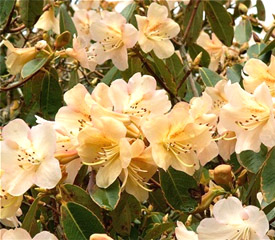Article Copied from the American Rhododendron Society Blog
Print date: 1/6/2026
"A" is for 'Alison Johnstone'
30 June 2013 @ 20:48 | Posted by Norma
I first saw Rhododendron 'Alison Johnstone' in a garden in the Oakland California area on a tour organized by the local chapter hosting the ARS conference. I can't remember the year, but I think it was in the late 80's or early 90's. I simply fell in love with "Alison" and started a hunt for a plant upon my return home. I was lucky enough to find one, but at the time, I was living in an apartment so I had to grow it in a container on the balcony. Some 20 plus years, and three moves later, it is still in a container, albeit a much larger one (a 90 liter pot) than when I started.

photo by Stuart Imrie
"Alison" blooms reliably every spring, and it's the flower colour that continues to attract me as it is such a curious colour. The flowers are not a true pink, but have almost an amber undertone which makes the colour hard to describe. I don't know of any other rhododendron that has quite the same flower colour. In addition, the foliage has a definite bluish cast which provides interesting foliage throughout the year.
Since my original plant is so big, I find the thought of trying to plant it in the ground too daunting, so this plant will spend its entire life in a container. Using a slow-release fertilizer, I fertilize at least twice a year: early April and again in late June and the plant gets lots and lots of water. Other than deadheading and maybe a bit of judicious pruning, this is all the care this big plant gets, but it seems happy and puts on new growth and flowers well each year. Others have told me that their 'Alison Johnstone' plants occasionally suffer from mildew, but I haven't found this to be a problem. However, I have a windy garden so my plant gets lots of air flow. I now have a second plant (won it in a raffle at one of our club meetings this spring), and this plant will get planted in the ground this fall.
Now, here's a curious problem I've never encountered before. I noticed earlier this week that there were suddenly dozens of healthy new leaves of my 'Alison Johnstone' lying on the ground around the plant. My other rhodies nearby were fine and I couldn't find any evidence of disease or insect pests that might be responsible. We haven't had any big wind storms recently, so that wouldn't have caused the problem either. I kept on going out and checking, and all I could find were yet more young leaves on the ground. Then, last evening, I noticed the leaves and branches were moving slightly, and sure enough, leaves fell off. I'm thinking, EEK, A RAT! - or something equally awful, but after watching for awhile, out popped a small wren. Since then, I've seen the wren flying in and out of the plant, and every time, more leaves appear on the ground. The bird doesn't appear to be eating anything, nor does it seem to be making a nest or using the leaves for anything. I know birds often break off small branches for nests, but this behaviour baffles me: I've never seen anything like it before, nor heard about this kind of behaviour. So if any of you bird watchers know why the wren is doing this, I'd love to hear the explanation. The only thing I can think of is that the wren shares my love of 'Alison Johnstone', but really, enough pruning already!